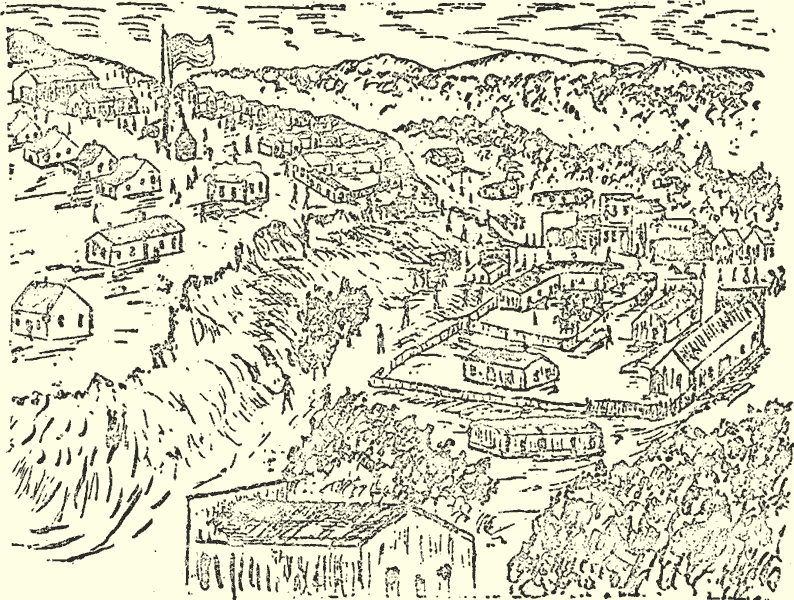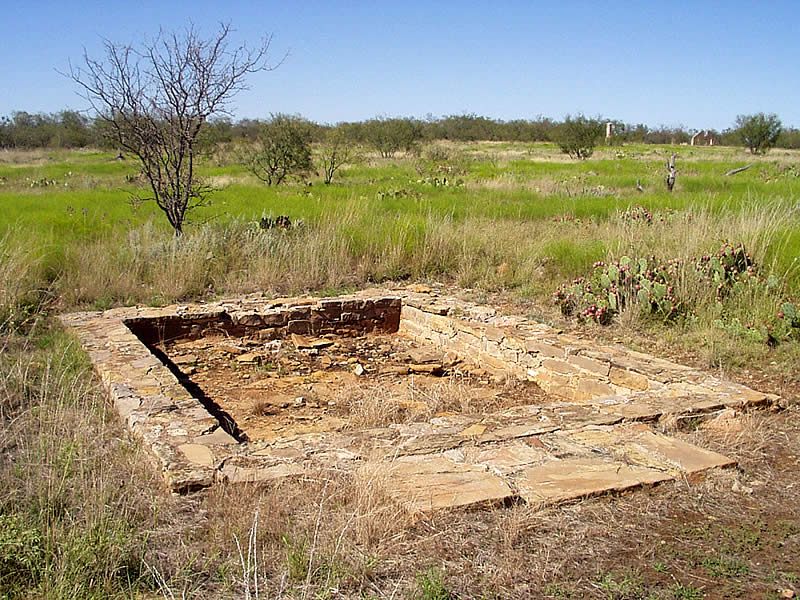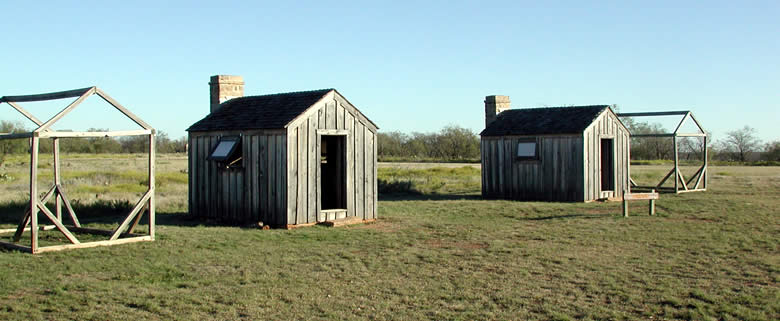|
Posted: 5/6/2015 9:51:12 PM EDT
Fort Griffin was one of a line of forts created in post-Civil War Texas to protect settlements moving into the Indian territories on the frontier. Active from 1867-1881, it was abandoned after the elimination of the buffalo herds due to hunting caused the Indians to move elsewhere. It was mostly built of wood, with just a few stone buildings whose remnants remain today. A town grew up next to the fort, which was a wild place, with gambling, prostitution, and saloons. Wyatt Earp and Doc Holliday actually met in that town. Currently, the state of Texas runs it as a state park and has a museum there along with interpretation of site remnants and a few rebuilt structures. Interestingly, there was a post library, which took pride in the fact that it had 100 books available for the troops to read.
Sketch of Fort Griffin overlooking the town known as The Flat below. Sketch circa 1876:
 "The U.S. Army's forts on the northwestern frontier of Texas were bound tightly to the ebb and flow of warfare with the Plains Indians. As each post outlived its purpose and was abandoned, civilians who had congregated nearby faced an uncertain future. Fort Griffin in its heyday spawned one of the liveliest and most notorious settlements in the West. The fort was the longest continuously-occupied post in the region, but the town that took its name barely survived the Army's departure in 1881.
"The U.S. Army's forts on the northwestern frontier of Texas were bound tightly to the ebb and flow of warfare with the Plains Indians. As each post outlived its purpose and was abandoned, civilians who had congregated nearby faced an uncertain future. Fort Griffin in its heyday spawned one of the liveliest and most notorious settlements in the West. The fort was the longest continuously-occupied post in the region, but the town that took its name barely survived the Army's departure in 1881.
The post that became Fort Griffin was established in the summer of 1867 by companies of the 6th Cavalry. The original site was in the bottoms of the Clear Fork of the Brazos River, a few miles downstream from the 1850s site of Camp Cooper. It was originally named Camp Wilson, for a recently deceased 6th Cavalry lieutenant, Henry Wilson. In 1868, it was renamed Fort Griffin, in honor of Colonel Charles Griffin, the departmental commandant who had himself recently died. More than just a name change was involved, however, as the post was moved away from the unhealthful bottoms to an adjacent plateau.
In later years, the location would be called "Government Hill" by some local residents. To the west, Collins Creek flowed around the base of the hill into the Clear Fork, and the creek served as the fort's water source for a time. A stronger stream east of the plateau furnished a location for a sawmill, and would be named "Mill Creek."
The scant architectural remains of both the fort and town belie the brief, but significant, life of each. The fort's bakery and powder magazine have been restored, and partial walls of the administration building and sutler's (post trader's) store still stand, along with a chimney from one of the officers' quarters. Foundations of numerous other buildings are visible on the grounds. Reconstructed frame buildings represent the size and style of enlisted quarters and mess."
http://www.texasbeyondhistory.net/forts/griffin/post.html
Stone foundation of sergeant's quarters:
 "As a military establishment, Fort Griffin was something of an afterthought of the Army throughout the life of the post. Plans for substantial permanent structures were drawn and approved, but most were never consummated. The Army had to request funds from the U.S. Congress for building materials, transportation, and skilled labor for each of its significant construction projects. In the meantime, temporary quarters were built from whatever local materials could be obtained, by enlisted personnel with whatever time and skills were available among them.
"As a military establishment, Fort Griffin was something of an afterthought of the Army throughout the life of the post. Plans for substantial permanent structures were drawn and approved, but most were never consummated. The Army had to request funds from the U.S. Congress for building materials, transportation, and skilled labor for each of its significant construction projects. In the meantime, temporary quarters were built from whatever local materials could be obtained, by enlisted personnel with whatever time and skills were available among them.
The Army high command never could quite get around to Fort Griffin, so local commanders made do with what they could cobble together. For the most part, that was "rawhide" lumber—so named because of its similarity to untanned, or "green," cattle and buffalo hides—milled at the nearby stream and fashioned into barracks and other buildings by whatever infantry companies were not on campaign. Foundations were chiseled from local limestone, possibly quarried from the base of the hill or hauled from nearby streambeds.
But the rawhide lumber shrank and warped as it dried, so that the wood was little better than mesquite brush as a defense against wind and rain. A favored alternative was "picket" construction—straight oak, pecan, and elm trunks and limbs set on end in shallow trenches and chinked with cattails, brush, rock, and mud. The alternative for many enlisted personnel was long-term use of the Army's short-term shelter, the canvas tent."
http://www.texasbeyondhistory.net/forts/griffin/post.html
Constructed of green "rawhide" lumber, buildings at the post tended to warp and could not withstand the elements. Here, two barracks for enlisted men have been reconstructed next to empty frames that mark the positions of others. The diminutive barracks each typically housed six men.
 "Almost immediately after the fort was completed, a new settlement began at the bottom of the hill, first called "The Bottom,” "The Flat” or "Hidetown,” before it took on the name of the fort. In addition to the honest pioneers who settled the area for legitimate reasons of ranching, agriculture, and commerce, in flooded a number of ruffians and outlaws.
"Almost immediately after the fort was completed, a new settlement began at the bottom of the hill, first called "The Bottom,” "The Flat” or "Hidetown,” before it took on the name of the fort. In addition to the honest pioneers who settled the area for legitimate reasons of ranching, agriculture, and commerce, in flooded a number of ruffians and outlaws.
When more and more people continued to arrive, the Indian attacks increased across northern Texas, keeping the soldiers busy in what was called the Red River Campaign, the battles of which continued until 1874, when the Texas Army defeated the Kiowas and Comanches at Palo Duro Canyon.
In the meantime, the settlement below the hill was bustling with buffalo hunters, business men, cowboys, outlaws, gamblers, gunfighters, and "painted ladies,” quickly gaining a reputation for lawlessness.
Some of these many people would later become well-known in the annals of history, including Doc Holliday and Wyatt Earp, who first met in Fort Griffin. Also there were Big Nose Kate; famous lady gambler, Lottie Deno; lawman, Pat Garrett, and gunfighter, John Wesley Hardin. "Marshaling” the lawless town was outlaw/lawman John M. Larn as sheriff, and his deputy, John Selman who, in the mid 1870’s, were working both sides of the law by controlling the vigilantes and rustling cattle. John Larn; however, would be killed by those same vigilantes inside his own jail in Fort Griffin. Selman, on the other hand, quickly disappeared and almost two decades later would kill John Wesley Hardin. During these lawless times, the settlement was so decadent that it was labeled "Babylon on the Brazos.”
In fact, in 1874, the place was so bad that the commander of the fort placed the town under its control, declaring martial law and forcing many of the undesirable residents to leave. The town remained under the army’s control until Shackelford County was officially formed later in the year. When the fort was built and the town below it sprang up, it was part of Jack County. However, at the same time that the town was boasting its bawdy ways in the extreme, there were also a number of law abiding citizens in the area that wanted to form a new county. Early in 1874, they petitioned the Jack County Court for permission to form their own county. In September, permission was granted and the new county was called Shackelford in honor of Dr. Jack Shackelford, a Texas revolutionary hero. Fort Griffin became the temporary county seat on October 12, 1874."
http://www.legendsofamerica.com/tx-fortgriffin.html
Barracks and mess hall at Ft. Griffin:
 Links to further documents and readings of Ft Griffin and that era
"Regardless of the living conditions, Fort Griffin assumed an important role in providing protection for the settlers and in the ultimate movement of the Kiowa and Comanche Indians from the West Texas frontier to reservations in the Indian Territory.
Links to further documents and readings of Ft Griffin and that era
"Regardless of the living conditions, Fort Griffin assumed an important role in providing protection for the settlers and in the ultimate movement of the Kiowa and Comanche Indians from the West Texas frontier to reservations in the Indian Territory.
Troops from Fort Griffin participated in all the decisive campaigns that ended the Kiowa and Comanche domination of northern Texas. Just to the north of the post at the junction of Collins Creek and the Clear Fork was home to the Tonkawa Indian scouts who also served admirably in the campaigns. In addition, Fort Griffin served as a key supply source for the Red River Campaign, which culminated in the final engagement at Palo Duro Canyon in September 1874.
As peace came to the frontier and military activity declined, the soldiers stationed at Fort Griffin were beset with long periods of boredom. In May, 1881, the Army determined that Fort Griffin was no longer a necessity to frontier defense, and the post was abandoned with the transfer of Co. A, 22nd Infantry to Fort Clark. By the mid-1800s the buffalo were gone, railroads had replaced the cattle trails, and the town of Albany was designated the county seat."
http://www.fortgriffin.org/id8.html
Ruins of the fort's administration building:

Fort Griffin Mini Documentary
https://youtu.be/HUWeCgWj8WM

Fort Griffin State Historic Site
https://youtu.be/FDIncQev6Lw

|
 Win a FREE Membership!
Win a FREE Membership!